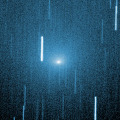
|
Now it is extremely bright as 4.5 mag (Mar. 21, Marco Goiato). It will pass only 0.036 a.u. from the earth on Mar. 21-22. In this apparition, it keeps observable in excellent condition both brightening and fading period. In the Northern Hemisphere, it will be unobservable temporarily in mid March. The orbital elements are similar to those of P/2016 BA14 ( PanSTARRS ).
Date(TT) R.A. (2000) Decl. Delta r Elong. m1 Best Time(A, h)
Mar. 19 7 6.21 -82 35.8 0.039 0.997 91 5.1 20:49 ( 0, 39)
Mar. 26 17 28.79 -35 47.0 0.045 1.008 101 4.9 4:43 (289, 83)
|

|
Now it is very bright as 8.7 mag (Feb. 14, Thomas Lehmann). It brightened temporarily in outburst in early January, but it returned to the original brightness. It will pass close to the earth from spring to summer, and it is expected to brighten up to 5-6 mag. Now it is not observable. In the Northern Hemisphere, it will appear in the morning sky again in late April, but it locates low in the south around the high light. In the Southern Hemisphere, it will be observable in excellent condition after appearing in the morning sky again in mid April.
Date(TT) R.A. (2000) Decl. Delta r Elong. m1 Best Time(A, h)
Mar. 19 23 34.73 4 42.8 2.384 1.402 7 7.7 4:37 (276,-17)
Mar. 26 23 34.61 3 52.7 2.332 1.370 11 7.5 4:43 (272,-10)
|

|
Now it is so bright as 9.2 mag (Mar. 11, Carlos Labordena). It is observable at 9-10 mag until spring in excellent condition in the Northern Hemisphere. It keeps unobservable in the Southern Hemisphere.
Date(TT) R.A. (2000) Decl. Delta r Elong. m1 Best Time(A, h)
Mar. 19 12 59.24 69 36.7 1.872 2.403 110 9.3 1:15 (180,-15)
Mar. 26 12 21.94 67 19.1 1.908 2.443 110 9.4 0:10 (180,-12)
|
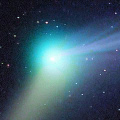
|
Now it is 9.9 mag (Mar. 11, Carlos Labordena). It was expected to brighten up to 4-5 mag from autumn to winter. But actually, it was 6 mag at best. Now it is fading rapidly. It is observable in excellent condition in the Northern Hemisphere. It is not observable after this in the Southern Hemisphere.
Date(TT) R.A. (2000) Decl. Delta r Elong. m1 Best Time(A, h)
Mar. 19 4 14.71 52 20.1 2.236 2.208 75 10.2 19:37 (153, -7)
Mar. 26 4 19.27 50 53.6 2.446 2.298 69 10.6 19:26 (150, -7)
|
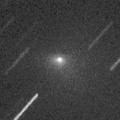
|
First return of an object discovered as an asteroid 2007 VA85 in 2007. It brightened very rapidly since mid February, and now it is so bright as 11.5 mag (Mar. 10, Marco Goiato). It will be getting lower after this. It will be unobservable in mid March in the Southern Hemisphere, or in late April in the Northern Hemisphere.
Date(TT) R.A. (2000) Decl. Delta r Elong. m1 Best Time(A, h)
Mar. 19 3 42.73 26 0.5 1.215 1.137 60 11.4 19:37 (131, 9)
Mar. 26 3 33.77 29 17.4 1.384 1.122 53 11.2 19:26 (129, 3)
|

|
Now it is 13.1 mag (Mar. 10, Thomas Lehmann). It keeps 12-13 mag for a long time from 2015 autumn to 2016 summer. In the Northern Hemispehre, it keeps observable in good condition for a long time. It keeps unobservable in the Southern Hemisphere.
Date(TT) R.A. (2000) Decl. Delta r Elong. m1 Best Time(A, h)
Mar. 19 20 33.03 66 15.4 2.738 2.672 75 12.2 4:37 (202,-22)
Mar. 26 20 29.03 67 7.4 2.736 2.675 75 12.2 4:43 (199,-20)
|
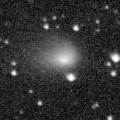
|
Now it is 12.6 mag (Mar. 9, Thomas Lehmann). It will brighten up to 11 mag from spring to summer. In the Northern Hemisphere, it keeps observable in good condition while the comet will be brightening. It locates somewhat low in the Southern Hemisphere.
Date(TT) R.A. (2000) Decl. Delta r Elong. m1 Best Time(A, h)
Mar. 19 5 32.62 21 55.5 1.806 1.986 85 12.5 19:37 (151, 27)
Mar. 26 5 43.07 22 13.6 1.847 1.949 80 12.4 19:26 (149, 26)
|
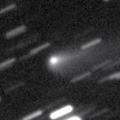
|
Now it is 13.4 mag (Feb. 11, Yasukazu Ikari). It will brighten up to 13 mag from winter to spring. It will be observable in excellent condition in the Southern Hemisphere. But it locates somewhat low in the Northern Hemisphere.
Date(TT) R.A. (2000) Decl. Delta r Elong. m1 Best Time(A, h)
Mar. 19 15 55.24 -21 51.6 1.599 2.238 117 13.3 4:08 (180, 77)
Mar. 26 15 58.43 -22 17.5 1.540 2.249 123 13.2 3:44 (180, 77)
|
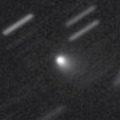
|
Now it is 15.0 mag (Mar. 7, Katsumi Yoshimoto). Brightening very rapidly, although it is somewhat fainter than this ephemeris. It will be observable at 11 mag in good condition from spring to summer.
Date(TT) R.A. (2000) Decl. Delta r Elong. m1 Best Time(A, h)
Mar. 19 12 13.11 20 0.6 1.036 2.001 160 13.6 0:27 (180, 35)
Mar. 26 12 6.34 20 37.4 1.006 1.963 156 13.3 23:48 (180, 34)
|

|
Now it is bright as 13.8 mag (Feb. 27, Michael Jager). Although it was faint as 19.0 mag in January (Jan. 10, B. Lutkenhoner), it brightened rapidly. It is observable at 14 mag until spring. But it locates extremely low in the Southern Hemisphere. The brightness differs in every apparition. It was not observed in the last apparition.
Date(TT) R.A. (2000) Decl. Delta r Elong. m1 Best Time(A, h)
Mar. 19 2 17.01 12 17.0 1.807 1.185 37 13.6 19:37 (108, 3)
Mar. 26 2 44.11 13 40.1 1.806 1.180 37 13.5 19:26 (110, 4)
|
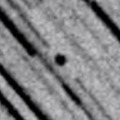
|
Now it is 12.8 mag (Mar. 22, Paul Camilleri). Almost completely stellar with no coma. It will pass only 0.024 a.u. from the earth on Mar. 23. It is expected to brighten very rapidly and reach up to 12-13 mag. It is observable in excellent condition in the Northern Hemisphere. In the Southern Hemisphere, it keeps observable in excellent condition until mid March, but it will be low after that. The orbital elements are similar to those of 252P/LINEAR.
Date(TT) R.A. (2000) Decl. Delta r Elong. m1 Best Time(A, h)
Mar. 19 7 21.58 -12 36.3 0.038 1.010 111 14.3 19:42 (180, 65)
Mar. 26 13 24.31 49 59.8 0.036 1.019 126 13.8 0:52 (180, 5)
|

|
Appearing in the morning sky. It brightened in outburst on Mar. 14 up to 14.8 mag (Jean-Francois Soulier).
Date(TT) R.A. (2000) Decl. Delta r Elong. m1 Best Time(A, h)
Mar. 19 19 39.73 -25 50.7 6.283 5.953 66 13.8 4:37 (271, 47)
Mar. 26 19 43.49 -25 42.3 6.177 5.951 72 13.8 4:43 (267, 53)
|

|
It brightened up to 3.7 mag and became a naked eye comet in mid January in 2015 (Jan. 13, Marek Biely). Now it is fading. It has already faded down to 14.6 mag (Jan. 26, Ken-ichi Kadota). In the Northern Hemisphere, it keeps observable for a long time until the comet fades out. It locates somewhat low in the Southern Hemisphere.
Date(TT) R.A. (2000) Decl. Delta r Elong. m1 Best Time(A, h)
Mar. 19 18 31.82 23 9.2 5.169 5.121 81 14.1 4:37 (212, 24)
Mar. 26 18 32.06 23 43.2 5.152 5.186 86 14.1 4:43 (204, 27)
|
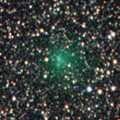
|
It is not observable now. It will appear in the morning sky in summer, but it will be fainter than 17 mag.
Date(TT) R.A. (2000) Decl. Delta r Elong. m1 Best Time(A, h)
Mar. 19 1 16.07 -0 43.5 2.798 1.896 20 14.4 19:37 ( 88, -1)
Mar. 26 1 32.03 0 54.1 2.863 1.938 17 14.7 19:26 ( 89, -3)
|
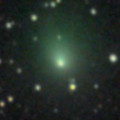
|
It is not observable now. It will appear in the morning sky in June. But the comet will be faint as 16-17 mag.
Date(TT) R.A. (2000) Decl. Delta r Elong. m1 Best Time(A, h)
Mar. 19 23 57.35 -3 13.6 3.092 2.099 2 14.5 19:37 ( 74,-16)
Mar. 26 0 11.57 -1 46.9 3.133 2.140 4 14.7 4:43 (282,-14)
|
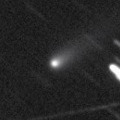
|
Now it is 14.9 mag (Mar. 7, Katsumi Yoshimoto). It is observable at 14-15 mag in good condition from winter to summer.
Date(TT) R.A. (2000) Decl. Delta r Elong. m1 Best Time(A, h)
Mar. 19 13 31.96 -8 51.1 1.429 2.364 154 14.7 1:46 (180, 64)
Mar. 26 13 25.31 -9 50.3 1.388 2.358 162 14.7 1:12 (180, 65)
|

|
Now it is 15.1 mag (Jan. 2, Ken-ichi Kadota). Distant object, but it keeps observable at 14-15 mag for a long time from 2015 to 2016. It becomes unobservable temporarily from January to March in the Southern Hemisphere, or from February to April in the Northern Hemisphere.
Date(TT) R.A. (2000) Decl. Delta r Elong. m1 Best Time(A, h)
Mar. 19 23 12.42 -2 45.5 5.883 4.909 10 14.8 4:37 (279, -8)
Mar. 26 23 19.55 -2 15.0 5.856 4.904 15 14.7 4:43 (275, -3)
|
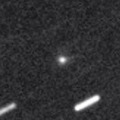
|
Now it is 16.2 mag (Feb. 17, La Silla--TRAPPIST). It will be observable at 14 mag in good condition from spring to summer.
Date(TT) R.A. (2000) Decl. Delta r Elong. m1 Best Time(A, h)
Mar. 19 19 30.45 -16 31.2 2.666 2.454 66 15.0 4:37 (258, 45)
Mar. 26 19 42.64 -16 0.8 2.584 2.446 70 14.9 4:43 (253, 49)
|

|
It will brighten up to 11 mag from summer to autumn. It will appear in the morning sky in summer, but it keeps low for some time.
Date(TT) R.A. (2000) Decl. Delta r Elong. m1 Best Time(A, h)
Mar. 19 23 28.69 8 4.0 3.074 2.104 10 15.4 4:37 (272,-18)
Mar. 26 23 43.42 9 27.6 3.022 2.055 11 15.2 4:43 (269,-15)
|

|
Now it is 16.2 mag (Feb. 7, Hiroshi Abe). It will brighten up to 14 mag in summer. But it is not observable at the highlight. It keeps observable until March while the comet will be brightening gradually up to 15-16 mag.
Date(TT) R.A. (2000) Decl. Delta r Elong. m1 Best Time(A, h)
Mar. 19 2 36.03 8 26.4 2.749 2.104 41 15.6 19:37 (107, 9)
Mar. 26 2 50.23 9 40.3 2.780 2.086 37 15.4 19:26 (108, 8)
|
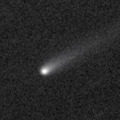
|
It brightened very rapidly in 2015 spring, and reached up to 13.8 mag (May 11, Sandor Szabo). It is bright as 14.3 mag still now (Feb. 11, Yasukazu Ikari). It keeps 15 mag for a while until spring. It is observable in excellent condition in the Southern Hemisphere. But it locates somewhat low in the Northern Hemisphere.
Date(TT) R.A. (2000) Decl. Delta r Elong. m1 Best Time(A, h)
Mar. 19 14 13.43 -30 7.4 3.212 3.979 134 15.6 2:27 (180, 85)
Mar. 26 14 10.99 -30 13.0 3.174 4.004 141 15.7 1:57 (180, 85)
|
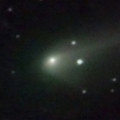
|
It brightened up to 11.1 mag in 2015 autumn (Sept. 21, Seiichi Yoshida). Now it is 14.6 mag (Mar. 9, Thomas Lehmann). It keeps observable in good condition after this, while the comet will be fading gradually.
Date(TT) R.A. (2000) Decl. Delta r Elong. m1 Best Time(A, h)
Mar. 19 11 36.92 12 51.4 1.630 2.609 166 15.7 23:46 (180, 42)
Mar. 26 11 30.02 13 11.3 1.700 2.660 160 15.9 23:12 (180, 42)
|
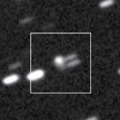
|
Now it is 15.9 mag (Feb. 11, Catalina Sky Survey). It is expected to brighten up to 7 mag in 2017 summer. In the Northern Hemisphere, it keeps observable in good condition until the highlight while the comet will be brightening. In the Southern Hemisphere, it is not observable until early 2017.
Date(TT) R.A. (2000) Decl. Delta r Elong. m1 Best Time(A, h)
Mar. 19 6 42.08 62 12.1 5.114 5.311 95 15.8 19:37 (175, -8)
Mar. 26 6 42.30 61 41.1 5.142 5.249 90 15.8 19:26 (173, -7)
|

|
STEREO spacecraft observed it at 8-9 mag on Feb. 21-22. It approached to the sun down to 0.58 a.u. on Mar. 9, but it was not observable around the perihelion passage. It will appear in the evening sky at 17 mag in late March. But it will fade out very rapidly.
Date(TT) R.A. (2000) Decl. Delta r Elong. m1 Best Time(A, h)
Mar. 19 1 25.38 4 4.2 1.381 0.607 23 15.8 19:37 ( 94, -2)
Mar. 26 2 11.89 7 21.7 1.342 0.662 28 16.7 19:26 (101, 2)
|

|
It will graze the surface of the sun on Apr. 10. It passed only 0.16 a.u. from the earth on Mar. 13, and it was observable in excellent condition. However, it was not visible, fainter than 19 mag (Mar. 17, Jean-Francois Soulier).
Date(TT) R.A. (2000) Decl. Delta r Elong. m1 Best Time(A, h)
Mar. 19 22 31.86 14 36.8 0.225 0.798 25 15.8 4:37 (258, -9)
Mar. 26 23 58.62 12 42.7 0.393 0.618 11 15.9 4:43 (268,-19)
|
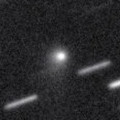
|
Now it is 15.6 mag (Feb. 11, Yasukazu Ikari). It keeps 15-16 mag for a long time until 2016. It keeps observable in excellent condition in the Northern Hemisphere. It keeps unobservable in the Southern Hemisphere.
Date(TT) R.A. (2000) Decl. Delta r Elong. m1 Best Time(A, h)
Mar. 19 3 13.50 72 13.7 5.427 5.330 79 15.9 19:37 (163,-26)
Mar. 26 3 23.98 72 19.5 5.501 5.342 75 16.0 19:26 (162,-26)
|
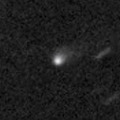
|
Now it is 16.3 mag (Feb. 11, Yasukazu Ikari). It will brighten up to 14 mag in 2017. In 2016, it keeps observable at 16 mag in good condition from winter to spring.
Date(TT) R.A. (2000) Decl. Delta r Elong. m1 Best Time(A, h)
Mar. 19 11 43.91 14 34.5 2.872 3.845 165 16.1 23:53 (180, 40)
Mar. 26 11 39.19 14 56.4 2.876 3.829 160 16.1 23:21 (180, 40)
|
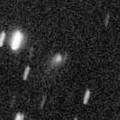
|
Now it is 15.5 mag (Feb. 11, Yasukazu Ikari). It brightened rapidly, and became brighter than originally expected. It keeps observable at 16 mag in good condition until May.
Date(TT) R.A. (2000) Decl. Delta r Elong. m1 Best Time(A, h)
Mar. 19 8 4.96 26 55.7 1.956 2.588 118 16.3 20:16 (180, 28)
Mar. 26 8 3.33 29 31.7 2.039 2.572 111 16.3 19:47 (180, 25)
|
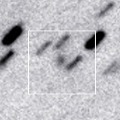
|
Now it is 16.1 mag (Feb. 3, Yasukazu Ikari). It keeps 16-17 mag for a long time from 2016 to 2019. It keeps locating near by the equator.
Date(TT) R.A. (2000) Decl. Delta r Elong. m1 Best Time(A, h)
Mar. 19 7 57.02 1 57.6 9.473 10.016 120 16.4 20:08 (180, 53)
Mar. 26 7 56.99 2 16.7 9.557 10.005 114 16.4 19:40 (180, 53)
|
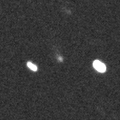
|
Now it is 16.3 mag (Feb. 2, Yasukazu Ikari). It keeps 16-17 mag for a long time until 2016 autumn. In the Southern Hemisphere, it keeps observable in good condition for a long time. In the Northern Hemisphere, it is observable only until March.
Date(TT) R.A. (2000) Decl. Delta r Elong. m1 Best Time(A, h)
Mar. 19 3 45.73 -29 0.1 2.825 2.513 61 16.5 19:37 ( 81, 44)
Mar. 26 3 50.20 -29 14.6 2.842 2.483 59 16.4 19:26 ( 80, 41)
|
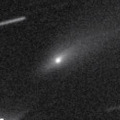
|
Now it is 17.2 mag (Feb. 18, D. Buczynski). In the Northern Hemisphere, it keeps observable in good condition after this while the comet will be fading. It locates low in the Southern Hemisphere.
Date(TT) R.A. (2000) Decl. Delta r Elong. m1 Best Time(A, h)
Mar. 19 14 6.03 29 34.6 2.309 3.116 137 16.6 2:20 (180, 26)
Mar. 26 13 59.11 30 11.2 2.331 3.160 139 16.7 1:45 (180, 25)
|
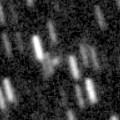
|
Now it is 17.7 mag (Feb. 5, La Silla--TRAPPIST). It keeps 16.5 mag for a long time in 2016, and it will be observable in excellent condition in the Southern Hemisphere. It is hardly observable in the Northern Hemisphere.
Date(TT) R.A. (2000) Decl. Delta r Elong. m1 Best Time(A, h)
Mar. 19 3 32.54 -47 31.1 3.674 3.400 66 16.6 19:37 ( 55, 45)
Mar. 26 3 30.67 -45 45.3 3.714 3.392 63 16.7 19:26 ( 57, 42)
|

|
Now it is 17.6 mag (Feb. 6, M. Jaeger, E. Prosperi, S. Prosperi, W. Vollmann). It will brighten up to 16 mag from March to June. It is observable in excellent condition in the Southern Hemisphere. It locates somewhat low in the Northern Hemisphere.
Date(TT) R.A. (2000) Decl. Delta r Elong. m1 Best Time(A, h)
Mar. 19 15 53.24 -17 39.4 1.337 2.014 118 16.8 4:06 (180, 73)
Mar. 26 15 55.53 -19 38.7 1.269 2.011 124 16.7 3:41 (180, 75)
|
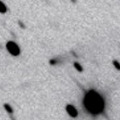
|
Now it is 16.6 mag (Feb. 19, D. Buczynski). It keeps observable at 17 mag in good condition from winter to spring.
Date(TT) R.A. (2000) Decl. Delta r Elong. m1 Best Time(A, h)
Mar. 19 15 14.87 2 58.1 1.812 2.567 129 17.0 3:28 (180, 52)
Mar. 26 15 13.97 3 14.0 1.764 2.578 136 17.0 3:00 (180, 52)
|

|
It brightened up to 11-12 mag in 2012. It has already faded down to 17.1 mag (Feb. 8, Catalina Sky Survey). It is observable at 17 mag in good condition from winter to spring.
Date(TT) R.A. (2000) Decl. Delta r Elong. m1 Best Time(A, h)
Mar. 19 10 39.71 -4 55.0 10.184 11.127 160 17.0 22:50 (180, 60)
Mar. 26 10 36.67 -4 34.8 10.260 11.165 154 17.1 22:19 (180, 60)
|
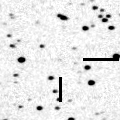
|
It was discovered around the aphelion in 2013 December. It keeps observable at 17 mag in good condition from 2016 to 2017. No observations have been reported since 2014 March.
Date(TT) R.A. (2000) Decl. Delta r Elong. m1 Best Time(A, h)
Mar. 19 12 47.10 3 45.3 1.988 2.965 166 17.2 1:01 (180, 51)
Mar. 26 12 41.27 4 16.7 1.942 2.932 171 17.1 0:28 (180, 51)
|
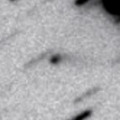
|
Now it is 16.8 mag (Feb. 11, Yasukazu Ikari). It keeps 17-18 mag for a long time until 2017 spring.
Date(TT) R.A. (2000) Decl. Delta r Elong. m1 Best Time(A, h)
Mar. 19 6 37.29 -10 18.6 3.567 3.871 100 17.1 19:37 (153, 63)
Mar. 26 6 40.08 -8 26.3 3.632 3.853 95 17.2 19:26 (148, 60)
|
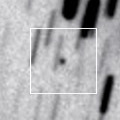
|
Now it is 17.1 mag (Jan. 17, K. Sarneczky, P. Szekely, T. Szalai). It brightened rapidly, and became brighter than originally expected. It keeps 17 mag until 2017. It is observable in excellent condition in the Northern Hemisphere. It is not observable in the Southern Hemisphere.
Date(TT) R.A. (2000) Decl. Delta r Elong. m1 Best Time(A, h)
Mar. 19 17 2.99 71 0.1 7.182 7.331 94 17.2 4:37 (183,-16)
Mar. 26 16 53.74 72 2.0 7.181 7.326 94 17.2 4:39 (180,-17)
|

|
It was observed as bright as 13-14 mag for a long time from 2011 to 2014. Now it is fading. It is observable in excellent condition in the Southern Hemisphere. It locates extremely low in the Northern Hemisphere.
Date(TT) R.A. (2000) Decl. Delta r Elong. m1 Best Time(A, h)
Mar. 19 18 13.66 -32 55.7 9.172 9.152 85 17.2 4:37 (273, 67)
Mar. 26 18 12.93 -33 17.5 9.084 9.186 92 17.2 4:43 (269, 74)
|
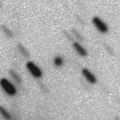
|
Now it is 16.9 mag (Feb. 5, Hiroshi Abe). It keeps observable in good condition for a while.
Date(TT) R.A. (2000) Decl. Delta r Elong. m1 Best Time(A, h)
Mar. 19 5 50.30 11 19.1 3.458 3.582 88 17.2 19:37 (150, 39)
Mar. 26 5 55.64 11 3.6 3.574 3.601 83 17.3 19:26 (146, 37)
|
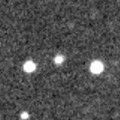
|
Now it is 17.5 mag (Feb. 16, H. Nohara). The cometary activity is confirmed recently. It is expected to brighten up to 7 mag in 2017 spring. But it locates somewhat low at the high light.
Date(TT) R.A. (2000) Decl. Delta r Elong. m1 Best Time(A, h)
Mar. 19 11 33.08 -4 24.1 4.295 5.284 172 17.4 23:43 (180, 59)
Mar. 26 11 28.75 -3 54.4 4.241 5.218 167 17.3 23:11 (180, 59)
|
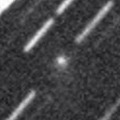
|
Now it is 17.2 mag (Feb. 11, Yuji Ohshima). It keeps observable at 17-18 mag until summer in the Northern Hemispehre. It is not observable after March in the Southern Hemisphere.
Date(TT) R.A. (2000) Decl. Delta r Elong. m1 Best Time(A, h)
Mar. 19 5 46.98 49 60.0 2.125 2.333 89 17.3 19:37 (164, 2)
Mar. 26 5 43.62 51 22.2 2.218 2.311 82 17.4 19:26 (162, 0)
|
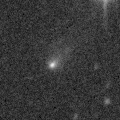
|
Now it is 16.8 mag (Feb. 7, Catalina Sky Survey). It must have been observable at 16-17 mag in good condition from summer to autumn in the Northern Hemisphere, but it was not discovered. It will be fading after this, and will be fainter than 18 mag in April.
Date(TT) R.A. (2000) Decl. Delta r Elong. m1 Best Time(A, h)
Mar. 19 10 52.21 26 24.4 1.880 2.788 150 17.3 23:01 (180, 29)
Mar. 26 10 41.51 24 35.1 1.967 2.836 144 17.5 22:23 (180, 31)
|

|
Now it is 17.4 mag (Feb. 11, Yasukazu Ikari). It was expected to brighten up to 14 mag from winter to summer. But it is much fainter actually. It will be observable in excellent condition in the Southern Hemisphere. It locates low in the Northern Hemisphere.
Date(TT) R.A. (2000) Decl. Delta r Elong. m1 Best Time(A, h)
Mar. 19 16 24.98 -30 23.4 1.830 2.350 108 17.4 4:37 (182, 85)
Mar. 26 16 30.71 -31 43.3 1.783 2.375 114 17.4 4:16 (180, 87)
|
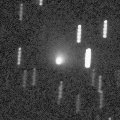
|
It kept brightening even after the perihelion passage, and brightened up to 13.0 mag (Dec. 21, Juan Jose Gonzalez). Now it is fading rapidly. It has already faded down to 15.4 mag (Feb. 7, Hiroshi Abe).
Date(TT) R.A. (2000) Decl. Delta r Elong. m1 Best Time(A, h)
Mar. 19 6 41.12 28 52.9 1.483 1.930 100 17.4 19:37 (169, 25)
Mar. 26 6 54.79 29 10.6 1.593 1.972 96 17.7 19:26 (169, 25)
|
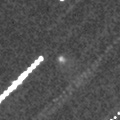
|
Now it is 17.0 mag (Mar. 17, Michael Jager). It is approaching to the earth down to 0.3 a.u., and moving very fast. It will be getting farther after this, and fade out rapidly. It is observable in excellent condition in the Northern Hemisphere. It will be extremely low after this in the Southern Hemisphere.
Date(TT) R.A. (2000) Decl. Delta r Elong. m1 Best Time(A, h)
Mar. 19 13 13.39 18 42.4 0.298 1.270 153 17.4 1:33 (180, 38)
Mar. 26 11 8.08 40 16.4 0.427 1.332 134 18.4 22:43 (180, 14)
|
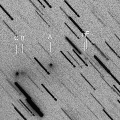
|
First return of a periodic comet which brightened up to 8 mag in major outburst in 2010. It will be observable in excellent condition from winter to spring. However, now it is faint; the fragment A is 17.8 mag (Feb. 24, Michael Jager), the fragment C is 17.8 mag (Feb. 24, Michael Jager), the fragment H is 18.5 mag (Feb. 24, Michael Jager). It will be 17 mag at best in this apparition. Fragments B to I are also observed in early February.
Date(TT) R.A. (2000) Decl. Delta r Elong. m1 Best Time(A, h)
Mar. 19 8 53.76 26 42.7 0.741 1.573 129 17.5 21:05 (180, 29)
Mar. 26 9 0.28 24 30.5 0.778 1.575 124 17.6 20:44 (180, 31)
|
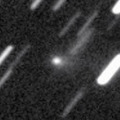
|
It brightened up to 15.7 mag in winter (Jan. 14, Toshiyuki Takahashi). Now it is fading. It has already faded down to 17.2 mag (Feb. 15, H. Boussier). It will be fainter than 18 mag in April. It locates somewhat low in the Southern Hemisphere.
Date(TT) R.A. (2000) Decl. Delta r Elong. m1 Best Time(A, h)
Mar. 19 7 53.44 29 52.9 1.767 2.375 115 17.5 20:05 (180, 25)
Mar. 26 7 58.34 30 9.0 1.851 2.381 109 17.6 19:42 (180, 25)
|
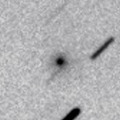
|
It brightened up to 16.0 mag in January (Jan. 18, Catalina Sky Survey). It will be fading after this, and will be fainter than 18 mag in Apri. It locates somewhat low in the Southern Hemisphere.
Date(TT) R.A. (2000) Decl. Delta r Elong. m1 Best Time(A, h)
Mar. 19 8 23.15 25 30.4 1.380 2.098 123 17.6 20:34 (180, 30)
Mar. 26 8 28.98 25 14.7 1.465 2.121 117 17.8 20:13 (180, 30)
|
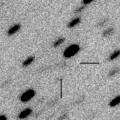
|
Now it is 18.7 mag (Jan. 14, Space Surveillance Telescope, Atom Site). It tends to be brightest after the perihelion passage. It is observable at 17 mag in excellent condition until March in the Northern Hemisphere. It locates low in the Southern Hemisphere.
Date(TT) R.A. (2000) Decl. Delta r Elong. m1 Best Time(A, h)
Mar. 19 6 32.28 33 0.4 1.251 1.706 98 17.6 19:37 (168, 21)
Mar. 26 6 49.31 31 34.6 1.310 1.714 95 17.7 19:26 (168, 22)
|
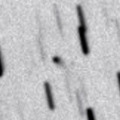
|
Now it is 17.4 mag (Feb. 11, Space Surveillance Telescope, Atom Site). It keeps 17.5 mag from 2016 to 2017. It is observable in good condition in the Northern Hemisphere. In the Southern Hemisphere, it locates low in 2016, and it is not observable in 2017.
Date(TT) R.A. (2000) Decl. Delta r Elong. m1 Best Time(A, h)
Mar. 19 17 29.13 20 18.8 6.323 6.507 96 17.7 4:37 (198, 33)
Mar. 26 17 29.57 21 37.6 6.230 6.494 100 17.7 4:43 (189, 33)
|

|
First return of a peculiar asteroid 1998 HO121. It brightened up to 16.5 mag in early 2015 (Jan. 4, M. Jaeger, E. Prosperi, S. Prosperi, W. Vollmann). It is observable at 17.5 mag again in 2016 spring.
Date(TT) R.A. (2000) Decl. Delta r Elong. m1 Best Time(A, h)
Mar. 19 13 58.68 -5 57.8 2.676 3.563 148 17.8 2:12 (180, 61)
Mar. 26 13 56.12 -5 18.4 2.655 3.589 155 17.7 1:42 (180, 60)
|
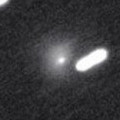
|
Very far object. Outburst occured on Feb. 20, 2015, and it brightened up to 15 mag. But it is faint as 18.5 mag now (Feb. 5, La Silla--TRAPPIST). . It is observable in excellent condition in the Southern Hemisphere. It locates somewhat low in the Northern Hemisphere.
Date(TT) R.A. (2000) Decl. Delta r Elong. m1 Best Time(A, h)
Mar. 19 13 28.53 -26 13.5 8.329 9.162 144 17.7 1:42 (180, 81)
Mar. 26 13 26.79 -26 4.7 8.277 9.164 151 17.7 1:13 (180, 81)
|
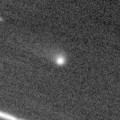
|
It brightened up to 16 mag in early 2015. Now it is 17.7 mag (Feb. 9, La Silla--TRAPPIST). It is observable at 18 mag from winter to spring.
Date(TT) R.A. (2000) Decl. Delta r Elong. m1 Best Time(A, h)
Mar. 19 9 0.10 -20 33.6 5.485 6.200 132 17.8 21:10 (180, 76)
Mar. 26 8 54.17 -19 40.7 5.577 6.225 126 17.9 20:37 (180, 75)
|
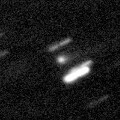
|
It brightened up to 15.2 mag in early 2015 (Feb. 24, Toshiyuki Takahashi). Now it is 17.5 mag (Dec. 6, Catalina Sky Survey). It will be fainter than 18 mag in April.
Date(TT) R.A. (2000) Decl. Delta r Elong. m1 Best Time(A, h)
Mar. 19 11 22.55 -4 38.7 3.893 4.877 170 17.9 23:32 (180, 60)
Mar. 26 11 19.46 -4 14.4 3.928 4.897 164 18.0 23:02 (180, 59)
|
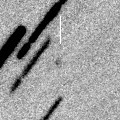
|
Now it is 17.9 mag (Mar. 3, Hidetaka Sato). It will be observable at 17.5 mag in good condition from April to May in the Southern Hemisphere. It is observable only until March in the Northern Hemisphere.
Date(TT) R.A. (2000) Decl. Delta r Elong. m1 Best Time(A, h)
Mar. 19 16 26.76 -34 14.4 1.008 1.618 107 18.1 4:37 (210, 89)
Mar. 26 16 41.95 -40 14.2 0.950 1.595 110 17.9 4:27 ( 0, 85)
|
|
![]()
 118P/Shoemaker-Levy 4
118P/Shoemaker-Levy 4 C/2014 W11 ( PanSTARRS )
C/2014 W11 ( PanSTARRS ) 67P/Churyumov-Gerasimenko
67P/Churyumov-Gerasimenko C/2015 V2 ( Johnson )
C/2015 V2 ( Johnson ) P/2003 T12 ( SOHO )
P/2003 T12 ( SOHO ) 321P/SOHO
321P/SOHO C/2013 V4 ( Catalina )
C/2013 V4 ( Catalina ) 65P/Gunn
65P/Gunn C/2015 Y1 ( LINEAR )
C/2015 Y1 ( LINEAR ) C/2014 B1 ( Schwartz )
C/2014 B1 ( Schwartz ) C/2015 T4 ( PanSTARRS )
C/2015 T4 ( PanSTARRS ) 19P/Borrelly
19P/Borrelly C/2015 B2 ( PanSTARRS )
C/2015 B2 ( PanSTARRS ) 100P/Hartley 1
100P/Hartley 1 180P/NEAT
180P/NEAT C/2006 S3 ( LONEOS )
C/2006 S3 ( LONEOS ) P/2013 YG46 ( Spacewatch )
P/2013 YG46 ( Spacewatch ) C/2015 X7 ( ATLAS )
C/2015 X7 ( ATLAS ) C/2014 R3 ( PanSTARRS )
C/2014 R3 ( PanSTARRS ) C/2010 S1 ( LINEAR )
C/2010 S1 ( LINEAR ) C/2015 X4 ( Elenin )
C/2015 X4 ( Elenin ) C/2015 ER61 ( PanSTARRS )
C/2015 ER61 ( PanSTARRS ) C/2015 W1 ( Gibbs )
C/2015 W1 ( Gibbs ) C/2015 YG1 ( NEOWISE )
C/2015 YG1 ( NEOWISE ) C/2014 Y1 ( PanSTARRS )
C/2014 Y1 ( PanSTARRS ) 230P/LINEAR
230P/LINEAR C/2016 E2 ( Kowalski )
C/2016 E2 ( Kowalski ) 332P/2015 Y2 ( Ikeya-Murakami )
332P/2015 Y2 ( Ikeya-Murakami ) 211P/Hill
211P/Hill 204P/LINEAR-NEAT
204P/LINEAR-NEAT 194P/LINEAR
194P/LINEAR C/2014 OE4 ( PanSTARRS )
C/2014 OE4 ( PanSTARRS ) (347449) 2012 TW236
(347449) 2012 TW236 C/2013 C2 ( Tenagra )
C/2013 C2 ( Tenagra ) C/2013 G9 ( Tenagra )
C/2013 G9 ( Tenagra ) 269P/2012 R2 ( Jedicke )
269P/2012 R2 ( Jedicke ) C/2016 C2 ( NEOWISE )
C/2016 C2 ( NEOWISE )![]()


















































